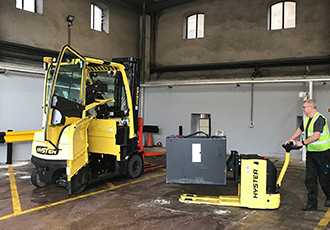Making the Connection: The Plug-in Vehicle Infrastructure Strategy - “Joined up approach vital to gain consumer confidence and private investment in electric vehicles,” says BEAMA CEO Dr Howard Porter
6th July 2011

While the Office of Low Emission Vehicles (OLEV) continues to oversee the completion of the Plugged-in-Places project, and promises to facilitate the plug-in vehicle market, the emphasis now grows on private investment to lead the way in the development of a mass market for plug-in vehicles.
Already there are significant achievements in infrastructure developments and the government subsidy (Plug-In Car Grant) has encouraged early adopters in this new market. However, now the challenge lies in how the market is to develop when public sector initiatives have been completed.
BEAMA’s CEO, Dr Howard Porter, emphasises that, “To ensure the appropriate level of private investment it is essential consumer confidence is gained in the new technologies for plug-in vehicles. For this to occur the appropriate standards need to be developed to provide interoperability between a national network of charging infrastructure which is safe and secure.
“It is essential we develop from the Plugged-in-Places projects commercial business models which will drive private investment. To do this will require a joined up working approach through which automotive, component and charge point manufacturers, distribution network operators and parking management companies will all work together to install the infrastructure where it is most needed. It is a key aim of BEAMA’s activity to facilitate this joined up working approach as we ensure our members engage with all aspects of the market.”
BEAMA has worked closely with OLEV in the development of the Plug-In Vehicle Infrastructure Strategy (published 30 June 2011), particularly on the proposals for building regulatory requirements for charging infrastructure. It is hoped this will be encouraged through the inclusion of electric vehicle charging infrastructure in the Code for Sustainable Homes.
Dr Porter continued: “BEAMA is very pleased with the work that has gone into initiating a UK plug-in electric vehicle market as it provides a great opportunity for our manufacturers to lead the way in the rollout of a mass market across Europe, providing thousands of green jobs.”
BEAMA, as an independent expert knowledge base and forum for the electro-technical industry in the UK, will provide a focus for the development of electrical infrastructures for plug-in vehicles, covering the development of appropriate standards, building regulations and wiring regulations. Progress is being driven by the BEAMA Electric Vehicle Infrastructure Project (BEVIP), providing specific expertise on the integration of charging infrastructure in the built environment.
Home Charging:
Dr Porter stated: “With the majority of charging anticipated to take place at home it is integral that the appropriate infrastructure will allow for the smart charging of plug-in vehicles, utilising off peak energy tariffs, which will be available with the rollout of smart metering across the UK. Plug-in vehicles, if charged smartly have the capacity to support the rollout of a smart grid by helping to regulate the peaks and troughs generated in the fluctuating supply of renewable energy.
“This could also allow effective use of the potential ‘excess’ renewable energy at times of low traditional demand. Without this level of network management a mass market of electric vehicles will emerge with little control over charging, resulting in an increased level of demand on the national grid infrastructure, which is likely to be very costly. This is one of the key reasons why BEAMA is developing a new smart grid task force to facilitate the interaction between different infrastructure product sectors, including groups such as the Smart Metering Association.
Building Regulatory Requirements for EV Charging:
“BEAMA is therefore very pleased with the recent publication of the ‘Zero Carbon Hub’s Allowable Solutions for Tomorrow’s New Home’, within which home electric vehicle charging infrastructure has been identified as an Allowable Solution. As well as promoting private investment, building regulatory requirements for charging infrastructure will go a long way to sure-up a charging network that can support a mass market for plug-in vehicles, ensuring ‘smart’ charging at home or at work. BEAMA will continue to work closely with OLEV and the IET in developing proposals for new wiring and building regulations which will go further to develop a secure charging infrastructure in new developments.”
BEAMA Guidance to EV Charging:
BEAMA, as a focus for expertise in this field, will work with UK partners to develop a guide to charging infrastructure, identifying the safety requirements for the charging of plug-in vehicles, in the domestic setting. This will answer frequently asked questions within the industry and BEAMA will work closely with the vehicle manufacturers to ensure the guide is used effectively to deliver consistent advice to consumers regarding the safe and responsible method of vehicle charging.
BEAMA’s CEO, Dr Howard Porter, emphasises that, “To ensure the appropriate level of private investment it is essential consumer confidence is gained in the new technologies for plug-in vehicles. For this to occur the appropriate standards need to be developed to provide interoperability between a national network of charging infrastructure which is safe and secure.
“It is essential we develop from the Plugged-in-Places projects commercial business models which will drive private investment. To do this will require a joined up working approach through which automotive, component and charge point manufacturers, distribution network operators and parking management companies will all work together to install the infrastructure where it is most needed. It is a key aim of BEAMA’s activity to facilitate this joined up working approach as we ensure our members engage with all aspects of the market.”
BEAMA has worked closely with OLEV in the development of the Plug-In Vehicle Infrastructure Strategy (published 30 June 2011), particularly on the proposals for building regulatory requirements for charging infrastructure. It is hoped this will be encouraged through the inclusion of electric vehicle charging infrastructure in the Code for Sustainable Homes.
Dr Porter continued: “BEAMA is very pleased with the work that has gone into initiating a UK plug-in electric vehicle market as it provides a great opportunity for our manufacturers to lead the way in the rollout of a mass market across Europe, providing thousands of green jobs.”
BEAMA, as an independent expert knowledge base and forum for the electro-technical industry in the UK, will provide a focus for the development of electrical infrastructures for plug-in vehicles, covering the development of appropriate standards, building regulations and wiring regulations. Progress is being driven by the BEAMA Electric Vehicle Infrastructure Project (BEVIP), providing specific expertise on the integration of charging infrastructure in the built environment.
Home Charging:
Dr Porter stated: “With the majority of charging anticipated to take place at home it is integral that the appropriate infrastructure will allow for the smart charging of plug-in vehicles, utilising off peak energy tariffs, which will be available with the rollout of smart metering across the UK. Plug-in vehicles, if charged smartly have the capacity to support the rollout of a smart grid by helping to regulate the peaks and troughs generated in the fluctuating supply of renewable energy.
“This could also allow effective use of the potential ‘excess’ renewable energy at times of low traditional demand. Without this level of network management a mass market of electric vehicles will emerge with little control over charging, resulting in an increased level of demand on the national grid infrastructure, which is likely to be very costly. This is one of the key reasons why BEAMA is developing a new smart grid task force to facilitate the interaction between different infrastructure product sectors, including groups such as the Smart Metering Association.
Building Regulatory Requirements for EV Charging:
“BEAMA is therefore very pleased with the recent publication of the ‘Zero Carbon Hub’s Allowable Solutions for Tomorrow’s New Home’, within which home electric vehicle charging infrastructure has been identified as an Allowable Solution. As well as promoting private investment, building regulatory requirements for charging infrastructure will go a long way to sure-up a charging network that can support a mass market for plug-in vehicles, ensuring ‘smart’ charging at home or at work. BEAMA will continue to work closely with OLEV and the IET in developing proposals for new wiring and building regulations which will go further to develop a secure charging infrastructure in new developments.”
BEAMA Guidance to EV Charging:
BEAMA, as a focus for expertise in this field, will work with UK partners to develop a guide to charging infrastructure, identifying the safety requirements for the charging of plug-in vehicles, in the domestic setting. This will answer frequently asked questions within the industry and BEAMA will work closely with the vehicle manufacturers to ensure the guide is used effectively to deliver consistent advice to consumers regarding the safe and responsible method of vehicle charging.
Similar articles
More from BEAMA (British Electrotechnical and Allied Manufacturers Association) Association
- Industry Forum gives boost to a ‘smarter’ electric vehicle future 16th December 2011
- New Energy Display Association Will Make Consumer Savings A Reality 25th November 2011
- BEAMA GOES ON THE ROAD 26th July 2011
- TWO NEW AND UPDATED – ‘ESSENTIAL READING’ - TECHNICAL GUIDES FROM BEAMA 13th July 2011




.jpg)







Write a comment
No comments